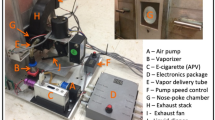Abstract
An ultrasonic nebulizer was used to create a drug vapor to develop an animal model for the self-administration of inhaled nonvolatile psychoactive drugs. An aerosol mist of a sufentanil citrate solution (10, 25, 50, or 75 μg/ml) was delivered to rats in response to lever presses on an FR 5 schedule of reinforcement. The speed of acquisition of the operant response and the selectivity of the drug effect were examined. Rats given access to sufentanil vapor (50 or 75 μg/ml) in 13–15 h overnight training sessions reached an average of one reinforcement per hour on an FR 5 schedule of reinforcement significantly sooner than did rats given access to water vapor. Responding maintained by sufentanil durign 2-h daily testing sessions was dose dependent at 25, 50, and 75 μg/ml. Substituting water vapor for each of the four sufentanil concentrations significantly reduced responding within 5–20 sessions. Naloxone (1 mg/kg, IP) decreased responding for sufentanil to the level attained under water vapor. Presentation of drugs in aerosol form thus provides reasonable means of demonstrating in animals the reinforcing properties of non-volatile drugs by the pulmonary or intranasal route.
Similar content being viewed by others
References
Ando K, Yanagita T (1981) Cigarette smoking in rhesus monkeys. Psychopharmacology 72:117–127
Balster RL (1987) Abuse potential evaluation of inhalants. Drug Aloohol Depend 19:7–15
Ettenberg A, Pettit HO, Bloom FE, Koob GF (1982) Heroin and cocaine intravenous self-administration in rats: mediation by separate neural systems. Pyschopharmacology 78:204–209
Hynes MD, Hymson DL (1984) Nitrous oxide generalizes to a discriminative stimulus produced by ethylketocyclazocine but not morphine. Eur J Pharmacol 105:155–159
Jarvik ME (1967) Tobacco smoking in monkeys. Ann NY Acad Sci 142:280–294
Koob GF, Petit HO, Ettenberg A, Bloom FE (1984) Effects of opiate antagonists and their quaternary derivatives on heroin self-administration in the rat. J Pharmacol Exp Ther 229:481–486
Leshem M (1988) Morphine induces delayed anorexia in rats. Psychopharmacology 94:254–258
Leysen JE, Gommeren W, Niemegeers CJE (1983) [3H] Sufentanil, a superior ligand for μ-opiate receptors: binding properties and regional distribution in rat brain and spinal cord. Eur J Pharmacol 87:209–225
Pickens R, Thompson T, Muchow DC (1973) Cannabis and phencyclidine self-administration in animals. In: Goldberg L, Hoffmeister F (eds) Bayer-symposium IV, psychic dependence: definition, assessment in animals and man, theoretical and clinical implications. Springer, New York Berlin Heidelberg Tokyo, pp 78–86
Schlesinger RB (1985) Comparative deposition of inhaled aerosols in experimental animals and humans: a review. J Toxicol Environ Health 15:197–214
Snyder C, Wood RW, Graefe JF, Bowers A, Magar K (1988) “Crack smoke” is a respirable aerosol of cocaine base. Pharmacol Biochem Behav 29:93–95
Wessinger WD, Martin BR, Balster RL (1985) Discriminative stimulus properties and brain distribution of phencyclidine in rats following administration by injection and smoke inhalation. Pharmacol Biochem Behav 23:607–612
Wood RW, Grubman J, Weiss B (1977) Nitrous oxide self-administration by the squirrel monkey. J Pharmacol Exp Ther 202:491–499
Woods JH, Schauster CR (1968) Reinforcement properties of morphine, cocaine, and SPA as a function of unit dose. Int J Addiet 3:231–236
Woods JH, Katz JL, Young AM, Medzihradsky F, Smith CB (1981) Correlations among certain behavioral physiological and biochemical effects of narcotic agonists. NIDA Res Monogr Ser 34:43–57
Yanagita T (1980) Self-administration studies on psychological dependence. TIPS 1:161–164
Yu CP, Diu CK (1983) Total and regional deposition of inhaled aerosols in humans. J Aerosol Sci 14:599–609
Author information
Authors and Affiliations
Rights and permissions
About this article
Cite this article
Jaffe, A.B., Sharpe, L.G. & Jaffe, J.H. Rats self-administer sufentanil in aerosol form. Psychopharmacology 99, 289–293 (1989). https://doi.org/10.1007/BF00445545
Received:
Accepted:
Issue Date:
DOI: https://doi.org/10.1007/BF00445545




